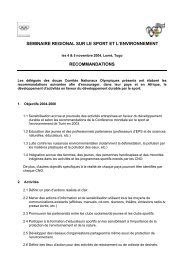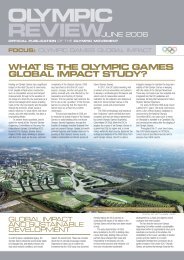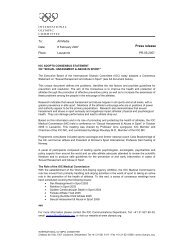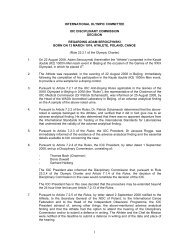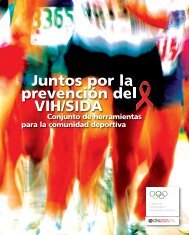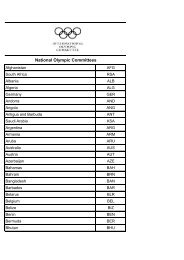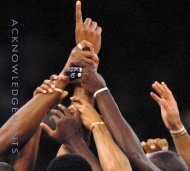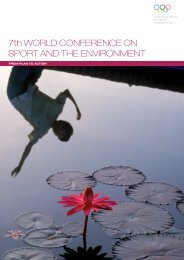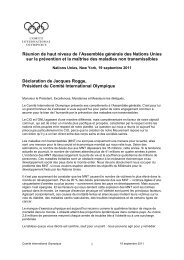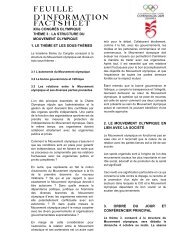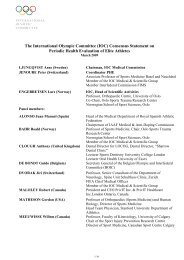Olympism in action - International Olympic Committee
Olympism in action - International Olympic Committee
Olympism in action - International Olympic Committee
Create successful ePaper yourself
Turn your PDF publications into a flip-book with our unique Google optimized e-Paper software.
OLYMPISM IN ACTION<br />
C H A P T E R S I X
Left and right<br />
Manuela Di Centa<br />
and Hicham El<br />
Guerrouj were both<br />
elected to the IOC<br />
Athletes’<br />
Commission, which<br />
gives athletes a<br />
direct voice with<strong>in</strong><br />
the IOC.<br />
O L Y M P I S M I N A C T I O N<br />
THE ATHLETES<br />
Athletes have a direct voice with<strong>in</strong> the IOC through election to the Athletes’ Commission. Created <strong>in</strong> 1981, the<br />
IOC Athletes’ Commission is made up of active and recently retired athletes. It is composed of 19 members,<br />
of whom there are eight summer sports athletes elected by their peers at the Games of the Olympiad, four<br />
w<strong>in</strong>ter sports athletes elected by their peers at the <strong>Olympic</strong> W<strong>in</strong>ter Games and up to seven athletes appo<strong>in</strong>ted<br />
by the IOC President to ensure a balance <strong>in</strong> terms of gender, sport and region. In addition, a World Olympians<br />
Association athlete representative and an <strong>International</strong> Paralympic <strong>Committee</strong> athlete representative are exofficio<br />
members.<br />
In 2002, at the XIX <strong>Olympic</strong> W<strong>in</strong>ter Games <strong>in</strong> Salt Lake City, Pernilla Wiberg of Sweden and Manuela Di<br />
Centa of Italy achieved the greatest number of votes to serve an eight-year term. The other two elected<br />
athletes, Jari Kurri of F<strong>in</strong>land and Ådne Søndrål of Norway, are serv<strong>in</strong>g a term of four years.<br />
In 2004, a total of 32 athletes, represent<strong>in</strong>g as many countries, ran for election to the IOC Athletes’<br />
Commission. The four elected were: Hicham El Guerrouj, Rania Elwani, Frank Fredericks and Jan Zelezny.<br />
A total of 5,787 athletes – 54.5 per cent of all those eligible – voted. Participation was higher than <strong>in</strong><br />
Sydney, where 47.2 per cent of the athletes voted. All the candidate athletes had to be presented by their<br />
National <strong>Olympic</strong> <strong>Committee</strong>. To be eligible, they had to have participated <strong>in</strong> the <strong>Olympic</strong> Games <strong>in</strong> either<br />
Sydney or Athens, and never been found guilty of a dop<strong>in</strong>g offence dur<strong>in</strong>g their sports career.<br />
The past quadrennium has seen the launch of two new l<strong>in</strong>ks between the IOC and athletes: the <strong>International</strong><br />
Athletes Forum and the Athletes Bullet<strong>in</strong>. In October 2002, the first <strong>International</strong> Athletes Forum was held <strong>in</strong><br />
Lausanne. Almost all of the 35 <strong>International</strong> <strong>Olympic</strong> Summer and W<strong>in</strong>ter Sports<br />
Federations had a representative present. Former <strong>Olympic</strong> pole vault champion<br />
Sergey Bubka, who replaced Peter Tallberg as Chairman of the IOC Athletes’<br />
Commission <strong>in</strong> 2002, was among a host of lead<strong>in</strong>g athletes who discussed three<br />
major topics: the fight aga<strong>in</strong>st dop<strong>in</strong>g; self-market<strong>in</strong>g for athletes dur<strong>in</strong>g and after their<br />
sport<strong>in</strong>g career; and the <strong>in</strong>tegration of professional athletes <strong>in</strong> the <strong>Olympic</strong> Movement.<br />
The ma<strong>in</strong> conclusions drawn from the Forum were the need for athletes to have total<br />
responsibility for any substance <strong>in</strong>take and that athletes who have retired had a vital role<br />
<strong>in</strong> educat<strong>in</strong>g youngsters about sport. Bubka said: “I am very pleased with this Forum. For<br />
the first time, athletes were given the opportunity to get across their messages and clearly<br />
express the need for them to be more <strong>in</strong>volved <strong>in</strong> the decision-mak<strong>in</strong>g process of sports organisations.”<br />
One concrete result of the Athletes Forum is the implementation of the “Athletes’ Career Programme”<br />
worldwide, which together with Adecco Group will help former athletes manage their career transition to<br />
successfully access the labour market.<br />
With the aim of improv<strong>in</strong>g communication, the Athletes Bullet<strong>in</strong> newsletter was launched <strong>in</strong> 2003. Close<br />
to 8,000 copies of the bil<strong>in</strong>gual (English and French) and bi-yearly newsletter are sent to Athletes’<br />
Commissions around the world. This provides the athletes with up-to-date <strong>in</strong>formation about the <strong>Olympic</strong><br />
Movement and the activities of the IOC Athletes’ Commission.<br />
63 IOC FINAL REPORT
O L Y M P I S M I N A C T I O N<br />
NATIONAL OLYMPIC COMMITTEES<br />
The National <strong>Olympic</strong> <strong>Committee</strong>s (NOCs) are responsible for develop<strong>in</strong>g and protect<strong>in</strong>g the <strong>Olympic</strong><br />
Movement <strong>in</strong> their respective countries. There are currently 202 National <strong>Olympic</strong> <strong>Committee</strong>s.<br />
IOC recognition was granted to the NOCs of Timor-Leste and Kiribati at the 115th Session <strong>in</strong> 2003.<br />
The NOC of Afghanistan, which had been suspended by the IOC <strong>in</strong> 1999 follow<strong>in</strong>g the take over of the<br />
Taliban regime, was re<strong>in</strong>stated <strong>in</strong> 2003. Five Afghan athletes, three men and two women, participated <strong>in</strong> the<br />
Athens Games.<br />
In early 2003 the NOC of Iraq was suspended by the IOC for violations of ethical pr<strong>in</strong>ciples and encouraged<br />
to reconstruct <strong>in</strong> compliance with the <strong>Olympic</strong> Charter. In early 2004 the IOC lifted the sanctions imposed<br />
aga<strong>in</strong>st the Iraqi NOC and supported the reconstruction process. Twenty-n<strong>in</strong>e Iraqi athletes participated <strong>in</strong> the<br />
Athens Games.<br />
INTERNATIONAL FEDERATIONS (IFS)<br />
The <strong>International</strong> Federations (IFs) have the responsibility and the duty to manage and to monitor the everyday<br />
runn<strong>in</strong>g of their sport on the <strong>in</strong>ternational level. The role of the IF is chiefly to ensure responsibility for the<br />
technical control and directions of their sports at the <strong>Olympic</strong> Games.<br />
The IOC provides fund<strong>in</strong>g for two types of IFs: <strong>Olympic</strong> IFs, whose sports are <strong>in</strong>cluded on the <strong>Olympic</strong><br />
Games Programme, and recognised IFs, whose sports are not on the <strong>Olympic</strong> Programme.<br />
There are currently 28 <strong>Olympic</strong> Summer Sports Federations, seven <strong>Olympic</strong> W<strong>in</strong>ter Sports Federations,<br />
and 29 Recognised <strong>International</strong> Federations (two of which are provisional).<br />
The Summer Sports Federations are: The <strong>International</strong> Archery Federation; The <strong>International</strong> Association<br />
of Athletics Federations; The <strong>International</strong> Badm<strong>in</strong>ton Federation; The <strong>International</strong> Baseball Federation; The<br />
<strong>International</strong> Basketball Federation; The <strong>International</strong> Box<strong>in</strong>g Association; The <strong>International</strong> Canoe Federation;<br />
The <strong>International</strong> Cycl<strong>in</strong>g Union; The <strong>International</strong> Equestrian Federation; The <strong>International</strong> Fenc<strong>in</strong>g<br />
Federation; The <strong>International</strong> Association Football Federation; The <strong>International</strong> Gymnastics Federation; The<br />
<strong>International</strong> Handball Federation; The <strong>International</strong> Hockey Federation; The <strong>International</strong> Judo Federation;<br />
The <strong>International</strong> Union of Modern Pentathlon; The <strong>International</strong> Row<strong>in</strong>g Federation; The <strong>International</strong> Sail<strong>in</strong>g<br />
Federation; The <strong>International</strong> Shoot<strong>in</strong>g Sport Federation; The <strong>International</strong> Softball Federation; The<br />
<strong>International</strong> Swimm<strong>in</strong>g Federation; The World Taekwondo Federation; The <strong>International</strong> Table Tennis<br />
Federation; The <strong>International</strong> Tennis Federation; The <strong>International</strong> Triathlon Federation; The <strong>International</strong><br />
Volleyball Federation; The <strong>International</strong> Weightlift<strong>in</strong>g Federation; The <strong>International</strong> Federation of Associated<br />
Wrestl<strong>in</strong>g Styles.<br />
The W<strong>in</strong>ter Sports Federations are: The <strong>International</strong> Biathlon Union; The <strong>International</strong> Bobsleigh and<br />
Toboggan<strong>in</strong>g Federation; The World Curl<strong>in</strong>g Federation; The <strong>International</strong> Ice Hockey Federation; The<br />
<strong>International</strong> Luge Federation; The <strong>International</strong> Skat<strong>in</strong>g Union; The <strong>International</strong> Ski Federation.<br />
With<strong>in</strong> the framework of relations with the IFs, the IOC also cont<strong>in</strong>ues to provide support to the<br />
<strong>International</strong> World Games Association (IWGA).<br />
64 IOC FINAL REPORT
Right Legendary race<br />
walker Robert<br />
Korzeniowski, who<br />
won <strong>Olympic</strong> gold<br />
medals at Atlanta,<br />
Sydney and Athens,<br />
benefited from an<br />
<strong>Olympic</strong> scholarship.<br />
O L Y M P I S M I N A C T I O N<br />
OLYMPIC SOLIDARITY<br />
For more than 30 years, <strong>Olympic</strong> Solidarity has been the body responsible for manag<strong>in</strong>g and adm<strong>in</strong>ister<strong>in</strong>g the<br />
share of the television rights of the <strong>Olympic</strong> Games that is allocated to the National <strong>Olympic</strong> <strong>Committee</strong>s (NOCs).<br />
It exercises this responsibility <strong>in</strong> accordance with the specific programmes of technical and f<strong>in</strong>ancial assistance<br />
approved by the <strong>Olympic</strong> Solidarity Commission. It assists the NOCs and their Cont<strong>in</strong>ental Associations with their<br />
efforts for the development of sport through programmes carefully devised to match their specific needs and<br />
priorities.<br />
For the 2001-2004 quadrennial period, the development and assistance budget was US$ 209,484,000,<br />
almost double the amount of US$ 121,900,000 from the previous quadrennium, and reflected a consistent and<br />
logical development, geared towards greater decentralisation of the programmes and their management<br />
towards the cont<strong>in</strong>ents and an <strong>in</strong>crease <strong>in</strong> the number of world programmes available (from 12 to 21). More<br />
than 14,000 activities <strong>in</strong> 202 NOCs were realised dur<strong>in</strong>g the 2001 to 2004 period.<br />
The <strong>Olympic</strong> Solidarity programmes are aimed at different protagonists <strong>in</strong> the world of sport and <strong>Olympism</strong>:<br />
athletes, coaches, sports leaders, NOCs and Cont<strong>in</strong>ental Associations.<br />
The focus of the 2001-2004 quadrennial plan was <strong>in</strong>creased programme decentralisation, with a budget<br />
of US$ 99,800,000 for the world programmes, managed from Lausanne, applied <strong>in</strong> an <strong>in</strong>dividual way to all<br />
NOCs and with a budget of US$ 69,944,000 for cont<strong>in</strong>ental programmes, managed by the five Cont<strong>in</strong>ental<br />
Associations, whose application and management were specific to each cont<strong>in</strong>ent.<br />
The rest of the <strong>Olympic</strong> Solidarity budget was made up of the follow<strong>in</strong>g:<br />
● US$ 31,240,000 – <strong>Olympic</strong> Games (f<strong>in</strong>ancial assistance to NOCs for participation);<br />
● US$ 8,500,000 – adm<strong>in</strong>istration and communication.<br />
WORLD PROGRAMMES<br />
<strong>Olympic</strong> Solidarity offered the NOCs 21 programmes cover<strong>in</strong>g a range of varied and complementary activities,<br />
divided <strong>in</strong>to four areas: athletes; coaches; NOC management; and special fields.<br />
US$ 43,500,000, the biggest s<strong>in</strong>gle amount allocated by <strong>Olympic</strong> Solidarity, was for the five programmes<br />
<strong>in</strong> the athletes’ category:<br />
● Salt Lake City 2002 – NOC preparation;<br />
● <strong>Olympic</strong> scholarships for athletes “Athens 2004”;<br />
● Athens 2004 – Team sport support grants;<br />
● Regional and Cont<strong>in</strong>ental Games – NOC Preparation;<br />
● Youth Development Programme.<br />
The success of the programme was evident from the <strong>Olympic</strong> W<strong>in</strong>ter Games <strong>in</strong> Salt Lake City <strong>in</strong><br />
2002. Fund<strong>in</strong>g was made available through <strong>Olympic</strong> Solidarity to 59 NOCs, 690 <strong>in</strong>dividual athletes<br />
and four ice hockey teams. From that, 402 athletes, from 56 NOCs, qualified and took part <strong>in</strong> 72 out<br />
of 78 events and six of the seven sports on the programme. <strong>Olympic</strong> Solidarity provided assistance to<br />
17% of the total number of athletes who took part <strong>in</strong> these Games. In preparation for the Athens<br />
65 IOC FINAL REPORT
O L Y M P I S M I N A C T I O N<br />
<strong>Olympic</strong> Games, <strong>Olympic</strong> Solidarity offered 55 team support grants to specific teams that had the possibility to<br />
qualify, or had already qualified for the Games.<br />
N<strong>in</strong>e hundred and thirty-n<strong>in</strong>e <strong>in</strong>dividual <strong>Olympic</strong> scholarships (652 men and 287 women) were allocated to<br />
athletes from more than 140 NOCs to allow athletes to qualify and prepare themselves for the Athens <strong>Olympic</strong><br />
Games <strong>in</strong> 2004. Five hundred and eighty-three <strong>Olympic</strong> scholarship holders from 141 NOCs managed to qualify<br />
for the Athens <strong>Olympic</strong> Games. Included <strong>in</strong> these, <strong>Olympic</strong> Solidarity made a special effort <strong>in</strong> relation to the<br />
athletes from the NOCs of Afghanistan and Iraq as they were aga<strong>in</strong> jo<strong>in</strong><strong>in</strong>g the <strong>Olympic</strong> movement at the<br />
celebration of the Athens <strong>Olympic</strong> Games. Fifty-seven medals and 105 diplomas were won by the <strong>Olympic</strong><br />
scholarship holders and 23 NOCs had over 50 per cent of their delegation made up by <strong>Olympic</strong> scholarship<br />
holders.<br />
COACHES<br />
The different options offered to the NOCs to tra<strong>in</strong> their national coaches are the programme of technical<br />
courses, the scholarships for coaches and the development of national coach<strong>in</strong>g structures, which allows the<br />
NOCs to benefit from the visit of an <strong>in</strong>ternational-level expert designated by the <strong>International</strong> Federation <strong>in</strong> the<br />
country to tra<strong>in</strong> the local coaches. The NOC may also propose a coach to be sent abroad to a university or highlevel<br />
tra<strong>in</strong><strong>in</strong>g centre to attend a tra<strong>in</strong><strong>in</strong>g programme <strong>in</strong> sports sciences or a specific programme <strong>in</strong> his/her sport.<br />
Dur<strong>in</strong>g the 2001-2004 quadrennial period, a total of 1,040 technical courses were organised world wide<br />
with the support of the IFs. Furthermore, 417 coaches from 130 NOCs benefited from the scholarships<br />
programme and f<strong>in</strong>ally, 141 development programmes were successfully conducted by the NOCs.<br />
NOC MANAGEMENT<br />
Us<strong>in</strong>g a fund of US$ 20,500,000, this section concentrated on NOC <strong>in</strong>frastructure, sports adm<strong>in</strong>istration, highlevel<br />
education for sports adm<strong>in</strong>istrators, NOC management consultancy and regional forums. The key to the<br />
efficient runn<strong>in</strong>g of an NOC is a solid management structure, ensur<strong>in</strong>g the development of sport at a national level.<br />
One option was a university tra<strong>in</strong><strong>in</strong>g network where participants who work for NOCs and National Federations<br />
are offered one of two possibilities: an Executive Masters <strong>in</strong> Sports Organisation Management (MEMOS) or<br />
scholarships for high level tra<strong>in</strong><strong>in</strong>g at a university of their choice.<br />
Each year, about 10 regional forums <strong>in</strong> collaboration with the respective Cont<strong>in</strong>ental Associations were<br />
organised on various themes <strong>in</strong> collaboration with groups of NOCs to discuss and debate topical issues.<br />
SPECIAL FIELDS<br />
The follow<strong>in</strong>g programmes, which fall under the special fields area, are aimed at assist<strong>in</strong>g the NOCs <strong>in</strong> their<br />
task to promote and dissem<strong>in</strong>ate the values and ideals of the <strong>Olympic</strong> Movement: Sports Medic<strong>in</strong>e; Sport and<br />
Environment; Women and Sport; <strong>International</strong> <strong>Olympic</strong> Academy; Sport for All; Culture and Education; and NOC<br />
Legacy. All the recognised NOCs have benefited from one or more of these programmes, for which a budget of<br />
US$ 12,800,000 was allocated.<br />
66 IOC FINAL REPORT<br />
Right A beneficiary of<br />
<strong>Olympic</strong> Solidarity,<br />
Croatia’s Janica<br />
Kostelic was one of<br />
the stars of Salt Lake<br />
City 2002, w<strong>in</strong>n<strong>in</strong>g<br />
four <strong>Olympic</strong> medals,<br />
<strong>in</strong>clud<strong>in</strong>g three golds.
O L Y M P I S M I N A C T I O N<br />
ATHLETES’ HEALTH<br />
The IOC Medical Commission, chaired by Arne Ljungqvist, aims to ensure athletes do not harm<br />
themselves as a result of tak<strong>in</strong>g illicit substances while, at the same time, ensur<strong>in</strong>g that there is a level<br />
play<strong>in</strong>g field for all competitors.<br />
ANTI-DOPING<br />
The World Anti-Dop<strong>in</strong>g Agency (WADA) was formed on 4 February 1999 to oversee how drug test<strong>in</strong>g is<br />
carried out across sports. On 21 August 2001, Montreal, Canada, was chosen as WADA’s permanent<br />
headquarters.<br />
Test<strong>in</strong>g procedures for prohibited substances are constantly improv<strong>in</strong>g. One of the best examples of<br />
that is the <strong>in</strong>troduction of test<strong>in</strong>g for erythropoiet<strong>in</strong> (EPO), which is believed to have been widely used <strong>in</strong><br />
endurance sports. In Salt Lake City <strong>in</strong> 2002, a total of 1,000 tests were performed and three positive<br />
results found evidence of darbepoet<strong>in</strong>, a stra<strong>in</strong> of EPO.<br />
The World Anti-Dop<strong>in</strong>g Code was signed at the<br />
World Conference on Dop<strong>in</strong>g <strong>in</strong> Sport <strong>in</strong><br />
Copenhagen <strong>in</strong> March 2003, and represents an<br />
important milestone <strong>in</strong> the fight aga<strong>in</strong>st dop<strong>in</strong>g.<br />
The IOC <strong>in</strong>sisted that all <strong>International</strong> Federations<br />
sign the code by the time that the 2004 <strong>Olympic</strong><br />
Games began or risk exclusion. The IOC has also<br />
called for governments to “accept” the Code and<br />
have it signed for the first day of the <strong>Olympic</strong><br />
W<strong>in</strong>ter Games <strong>in</strong> 2006 <strong>in</strong> Tur<strong>in</strong>.<br />
At the 2004 <strong>Olympic</strong> Games <strong>in</strong> Athens, 3,667<br />
anti-dop<strong>in</strong>g controls were conducted and 26<br />
athletes were disqualified for violation of the IOC<br />
anti-dop<strong>in</strong>g rules.<br />
With sportsmen and women <strong>in</strong>creas<strong>in</strong>gly be<strong>in</strong>g<br />
subject to out-of-competition test<strong>in</strong>g and even be<strong>in</strong>g sanctioned when there is a suspicion of foul-play,<br />
such as repeatedly not be<strong>in</strong>g available to give ur<strong>in</strong>e samples, the IOC’s message is clear. It is: zerotolerance<br />
for cheats.<br />
NUTRITION<br />
The IOC Medical Commission has broadened its scope of <strong>action</strong>. Mov<strong>in</strong>g from a focus solely on antidop<strong>in</strong>g<br />
activities, now a responsibility of WADA dur<strong>in</strong>g non-Games times, the Commission has developed<br />
a detailed programme aimed at protect<strong>in</strong>g the health of the athletes.<br />
In 2003, the IOC Consensus Conference on Nutrition <strong>in</strong> Sport was organised, which led to the draft<strong>in</strong>g<br />
68 IOC FINAL REPORT<br />
Left At Athens 2004,<br />
3,667 anti-dop<strong>in</strong>g<br />
controls were<br />
conducted and 26<br />
athletes were<br />
disqualified for<br />
violation of the IOC<br />
anti-dop<strong>in</strong>g rules.
O L Y M P I S M I N A C T I O N<br />
of a consensus statement on sports nutrition.<br />
Based on this consensus, “Nutrition for Athletes”, a practical guide to eat<strong>in</strong>g for health and<br />
performance was launched by the IOC Medical Commission and distributed to athletes compet<strong>in</strong>g <strong>in</strong><br />
Athens. The booklet’s f<strong>in</strong>al summary was <strong>in</strong> the form of the “IOC Consensus Statement on Sports<br />
Nutrition 2003”, <strong>in</strong> which it underl<strong>in</strong>es that “good nutritional practice will help athletes tra<strong>in</strong> hard, recover<br />
quickly and adapt more effectively with less risk of illness and <strong>in</strong>jury”.<br />
SUDDEN DEATH CONSENSUS MEETING<br />
In 2004, the “Lausanne Recommendations”, a consensus paper on the prevention of sudden death was<br />
adopted follow<strong>in</strong>g a meet<strong>in</strong>g on “Sudden Cardiovascular Death <strong>in</strong> Sport”.<br />
The purpose of these recommendations is to identify, as accurately as possible, athletes at risk <strong>in</strong><br />
order to advise them accord<strong>in</strong>gly.<br />
IOC OLYMPIC WORLD CONGRESS ON SPORT SCIENCES<br />
The sixth IOC <strong>Olympic</strong> World Congress on Sports Sciences took place <strong>in</strong> 2002 together with the 49th<br />
annual meet<strong>in</strong>g of the American College of Sports Medic<strong>in</strong>e (ACSM) <strong>in</strong> St Louis, USA.<br />
The seventh IOC <strong>Olympic</strong> World Congress on Sports Sciences was held <strong>in</strong> 2003 <strong>in</strong> Athens. One<br />
thousand scientists from around the world participated <strong>in</strong> the Congress for which the theme was<br />
“Physical, Nutritional and Psychological Care of the Athletes <strong>in</strong> the 21st Century”. The Congress provided<br />
the world’s lead<strong>in</strong>g sports medic<strong>in</strong>e experts with an opportunity to present their work to an <strong>in</strong>ternational<br />
audience which is <strong>in</strong> l<strong>in</strong>e with the IOC Medical Commission’s pr<strong>in</strong>ciple to allow the highest number of<br />
people to have access to the best knowledge <strong>in</strong> all fields related to sports sciences.<br />
ETHICS<br />
In 1999, the IOC’s Executive Board created an <strong>in</strong>dependent Ethics Commission compris<strong>in</strong>g eight<br />
members. The Commission is chaired by Judge Kéba Mbaye.<br />
The Ethics Commission has three roles. First, it draws up and constantly updates a framework of<br />
ethical pr<strong>in</strong>ciples, <strong>in</strong>clud<strong>in</strong>g a Code of Ethics based on the values and pr<strong>in</strong>ciples enshr<strong>in</strong>ed <strong>in</strong> the <strong>Olympic</strong><br />
Charter. It also plays a monitor<strong>in</strong>g role, and as such ensures that ethical pr<strong>in</strong>ciples are respected; it<br />
conducts <strong>in</strong>vestigations <strong>in</strong>to breaches of ethics submitted to it, and, when needed, makes<br />
recommendations to the Executive Board. Lastly, it has a preventive mission, advis<strong>in</strong>g the <strong>Olympic</strong><br />
parties on the application of the ethical pr<strong>in</strong>ciples and rules.<br />
The “Foundation for Universal <strong>Olympic</strong> Ethics” was created <strong>in</strong> 2001 <strong>in</strong> order to ensure the Ethics<br />
Commission’s <strong>in</strong>dependence and to help it carry out its tasks as conferred on it by the <strong>Olympic</strong> Charter<br />
or the IOC. It allows the Ethics Commission to ensure the strict application of the IOC Code of Ethics and<br />
to promote ethical pr<strong>in</strong>ciples throughout all the entities of the <strong>Olympic</strong> Movement (IOC, NOCs and<br />
<strong>International</strong> Sports Federations) and with<strong>in</strong> sport <strong>in</strong> general.<br />
69 IOC FINAL REPORT
O L Y M P I S M I N A C T I O N<br />
WOMEN AND SPORT<br />
The Women and Sport Work<strong>in</strong>g Group, established <strong>in</strong> 1995, became an IOC Commission <strong>in</strong> 2004, the same<br />
year that saw record numbers of women compet<strong>in</strong>g at the Summer Games.<br />
At Athens 2004, the percentage of women participat<strong>in</strong>g was higher than ever. Of the 10,625 athletes,<br />
4,329 – or 41 per cent – were women. The figures from Athens were double that from 1976, when<br />
the Summer Games were staged <strong>in</strong> Montreal, and triple that of Tokyo 1964. They showed a steady <strong>in</strong>crease,<br />
too, from Atlanta, <strong>in</strong> 1996, when the figure was 34.2 per cent, and Sydney, <strong>in</strong> 2000, when it was<br />
38.2 per cent.<br />
Indeed, the IOC had been work<strong>in</strong>g with Organis<strong>in</strong>g <strong>Committee</strong>s and <strong>International</strong> Sports Federations to<br />
ensure that the Games programme was enlarged to <strong>in</strong>clude more women <strong>in</strong> the sports, discipl<strong>in</strong>es and<br />
events.<br />
Thanks to this cooperation, Athens 2004 also set a record for the number of events that women could<br />
compete <strong>in</strong>: 135 or 48 per cent out of all events compared to 132 (44 per cent) <strong>in</strong> Sydney and 108 (40 per<br />
cent) <strong>in</strong> Atlanta. Every Summer Games sport was open to women <strong>in</strong> Athens, except baseball – which has a<br />
similar sport for women <strong>in</strong> softball – and box<strong>in</strong>g.<br />
In Salt Lake City, <strong>in</strong> 2002, 37 per cent of the athletes participat<strong>in</strong>g <strong>in</strong> the Games<br />
were women.Women’s skeleton was a medal event at the Games for the first time,<br />
along with 1500m short track skat<strong>in</strong>g, the cross country spr<strong>in</strong>t <strong>in</strong> ski<strong>in</strong>g and<br />
biathlon pursuit.<br />
Gender equality needed further support to be more effective, <strong>in</strong>clud<strong>in</strong>g<br />
outside the field of play. The IOC therefore established a “target policy” <strong>in</strong> 1996 to<br />
have a female membership of at least 10 per cent of the executive and legislative<br />
functions of each NOC by 2000, and at least 20 per cent by the end of<br />
2005. At the end of 2004, 54 NOCs had reached this target, while 125<br />
had a female membership of more than 10 per cent of their executive<br />
board and 181 had at least one woman on their board.<br />
The IOC itself is striv<strong>in</strong>g to reach the target, with just over 10<br />
per cent, as its pledge to reduce its overall membership to 115<br />
seriously curtails the <strong>in</strong>take of new members and affects the<br />
election of female members as well. Nevertheless, it is worth<br />
mention<strong>in</strong>g that Gunilla L<strong>in</strong>dberg, IOC member from Sweden,<br />
became the second woman <strong>in</strong> its history to be elected<br />
Vice-President. The only other woman to have held this position<br />
<strong>in</strong> the past is Anita DeFrantz, of the USA, IOC member and<br />
Chairwoman of the IOC Women and Sport Commission, and <strong>Olympic</strong><br />
bronze medallist <strong>in</strong> row<strong>in</strong>g. The IOC also appo<strong>in</strong>ted Giselle Davies<br />
as its Director of Communications, while other women <strong>in</strong> the<br />
70 IOC FINAL REPORT<br />
Left Denmark’s<br />
Krist<strong>in</strong>e Andersen<br />
celebrates after<br />
scor<strong>in</strong>g a goal <strong>in</strong> the<br />
women’s handball<br />
gold medal match at<br />
Athens 2004.<br />
Above right Tristan<br />
Gale of the USA won<br />
a gold medal <strong>in</strong> the<br />
women’s skeleton at<br />
Salt Lake City 2002,<br />
the first Games at<br />
which <strong>Olympic</strong><br />
medals were<br />
awarded <strong>in</strong> this<br />
event.<br />
Below right The IOC<br />
Women and Sport<br />
trophy.
O L Y M P I S M I N A C T I O N<br />
adm<strong>in</strong>istration have ga<strong>in</strong>ed higher profiles <strong>in</strong> the senior<br />
management.<br />
The IOC target policy for women’s leadership was<br />
analysed through a jo<strong>in</strong>t research project that the IOC<br />
and Loughborough University <strong>in</strong> the United K<strong>in</strong>gdom,<br />
with a team of experienced researchers, undertook<br />
over two years, with questionnaires to and<br />
<strong>in</strong>terviews with National <strong>Olympic</strong> <strong>Committee</strong>s’<br />
sport leaders, both men and women.<br />
The results highlighted several successes of<br />
this target policy, <strong>in</strong>clud<strong>in</strong>g a significant <strong>in</strong>crease<br />
of women <strong>in</strong> leadership roles at NOC level,<br />
awareness-rais<strong>in</strong>g about gender <strong>in</strong>equalities,<br />
the possibility for talented women to enter<br />
the <strong>Olympic</strong> Movement and overall an<br />
improved <strong>Olympic</strong> governance.<br />
In addition to this good practice, the results<br />
also recommended that further work would be<br />
necessary with NOC Cont<strong>in</strong>ental Associations,<br />
NOC Women’s <strong>Committee</strong>s and other members of<br />
the <strong>Olympic</strong> Family, <strong>in</strong> particular <strong>International</strong><br />
and National Federations, to enable gender equality<br />
from grass-root level to the top.<br />
This quadrennium also saw the organisation of the III World Conference on Women and Sport <strong>in</strong><br />
Marrakech, Morocco, <strong>in</strong> March 2004, a conference attended by more than 600 delegates from 137<br />
countries. The Conference reaffirmed its support to the IOC target policy and urged the IOC, IFs, Sports<br />
Confederations, NOCs and NFs to correct the current and rema<strong>in</strong><strong>in</strong>g gender imbalance. It also recalled the<br />
need to secure physical education <strong>in</strong> school curricula, as well as call<strong>in</strong>g for <strong>in</strong>creased <strong>in</strong>ternational<br />
partnership with <strong>in</strong>ternational organisations deal<strong>in</strong>g with gender equality. It further advocated for additional<br />
funds from <strong>Olympic</strong> Solidarity for women’s activities, as well as a fairer and more accurate portrayal of<br />
women’s sport <strong>in</strong> the media.<br />
The IOC has also organised more than 10 regional sem<strong>in</strong>ars for NOCs on the five cont<strong>in</strong>ents dur<strong>in</strong>g the<br />
last four years, aim<strong>in</strong>g to educate women on their roles to promote gender, and gender-related and social<br />
issues through sport.<br />
S<strong>in</strong>ce 2000, the IOC has awarded annually a Women and Sport Trophy, at cont<strong>in</strong>ental and world level. It<br />
is meant as a tool to <strong>in</strong>crease visibility and recognition of role models, be they women, men or <strong>in</strong>stitutions,<br />
<strong>in</strong> the promotion and advocacy of gender equality.<br />
71 IOC FINAL REPORT
O L Y M P I S M I N A C T I O N<br />
OLYMPIC TRUCE<br />
The idea of a symbolic <strong>in</strong>ternational truce has been revived by the IOC s<strong>in</strong>ce 1992 with numerous<br />
<strong>in</strong>itiatives to promote peace and understand<strong>in</strong>g through sport and the <strong>Olympic</strong> Games.<br />
A signature campaign has also been launched s<strong>in</strong>ce 2001, aim<strong>in</strong>g to gather the statement of world<br />
personalities, <strong>in</strong> their <strong>in</strong>dividual capacities, <strong>in</strong> support of the <strong>Olympic</strong> Truce. This statement constitutes a<br />
non-b<strong>in</strong>d<strong>in</strong>g symbolic appeal. Every signatory engages himself to act as a Truce Ambassador.<br />
The <strong>Olympic</strong> Truce signature campaign was officially announced dur<strong>in</strong>g the flame-light<strong>in</strong>g ceremony<br />
for the XIX <strong>Olympic</strong> W<strong>in</strong>ter Games <strong>in</strong> November 2001 <strong>in</strong> Olympia. The Statement was <strong>in</strong>itially signed by<br />
foreign m<strong>in</strong>isters from countries <strong>in</strong> South-Eastern Europe, some of which have recently experienced<br />
conflict. The launch ceremony of the <strong>Olympic</strong> Family signature campaign <strong>in</strong> support of the <strong>Olympic</strong> Truce<br />
officially took place at the 115th IOC Session <strong>in</strong> Prague, where every IOC member, bid committee and any<br />
person with access to the function rooms was able to add their signatures to the campaign.<br />
In June and July 2002, two former Presidents, Nelson Mandela, of South Africa, and Bill Cl<strong>in</strong>ton, of<br />
the USA, signed the Statement, jo<strong>in</strong><strong>in</strong>g over 350 world personalities <strong>in</strong>clud<strong>in</strong>g heads of state and<br />
government, religious leaders, heads of <strong>in</strong>ternational organisations, <strong>Olympic</strong> Movement officials and<br />
personalities from literature and the arts. In Salt Lake City, an <strong>Olympic</strong> Peace Pole pathway had 77 poles,<br />
one for each of the compet<strong>in</strong>g countries and with the words: “May Peace Prevail on Earth”.<br />
In November 2003, a resolution on the <strong>Olympic</strong> Truce was tabled at the UN General Assembly by<br />
Greece, the host country of the 2004 edition of the <strong>Olympic</strong> Games. The Resolution was co-sponsored by<br />
190 UN member states, a record number <strong>in</strong> United Nations history. It followed similar resolutions adopted<br />
for the Summer and W<strong>in</strong>ter Games of 2000 and 2002.<br />
In the build-up to the Games of the XXVIII Olympiad <strong>in</strong> the summer of 2004, ATHOC used its Torch<br />
Relay to promote the <strong>Olympic</strong> Truce and peace through sport. The first truly global <strong>Olympic</strong> Torch Relay,<br />
it lasted 65 days, and travelled five cont<strong>in</strong>ents, start<strong>in</strong>g <strong>in</strong> Ancient Olympia at the end of March and<br />
return<strong>in</strong>g to Greece for the Games. The <strong>Olympic</strong> torch came to the United Nations for the first time <strong>in</strong> June<br />
2004; the world organisation sent it on its global journey with an appeal for a halt to all fight<strong>in</strong>g dur<strong>in</strong>g<br />
the Summer Games and a silent prayer for last<strong>in</strong>g peace.<br />
The <strong>International</strong> <strong>Olympic</strong> Truce Centre (IOTC) launched the “<strong>Olympic</strong> Truce Wall” <strong>in</strong> Athens, prior to<br />
the Games, where more than 20 heads of state and government, as well as representatives of the <strong>Olympic</strong><br />
Movement, were <strong>in</strong>vited to renew their <strong>in</strong>dividual support for peace and understand<strong>in</strong>g through sport. To<br />
promote the <strong>in</strong>itiative, the “Truce Story”, a cartoon book, was published <strong>in</strong> 2003. It is meant for students<br />
between the ages of 13 to 19, and is written <strong>in</strong> seven languages: Arabic, Ch<strong>in</strong>ese, Greek, English, French,<br />
Russian and Spanish. It has been officially adopted by UNESCO and was taught on a pilot basis <strong>in</strong> schools<br />
<strong>in</strong> UNESCO’s Associated Schools Network Project <strong>in</strong> over 60 countries, <strong>in</strong>clud<strong>in</strong>g <strong>in</strong> conflict regions.<br />
In cooperation with the IOTC, the IOC organised two regional forums on peace and sport <strong>in</strong> Nicosia<br />
(Cyprus) and Nairobi (Kenya) <strong>in</strong> July 2004. National <strong>Olympic</strong> <strong>Committee</strong>s of European and Middle-<br />
Eastern countries affected by conflict, <strong>in</strong>clud<strong>in</strong>g Israel and Palest<strong>in</strong>e, gathered to discuss the<br />
72 IOC FINAL REPORT<br />
Left and right In the<br />
build-up to the<br />
Games of the XXVIII<br />
Olympiad, ATHOC<br />
used its Torch Relay<br />
to promote the<br />
<strong>Olympic</strong> Truce and<br />
peace through sport.
O L Y M P I S M I N A C T I O N<br />
contribution of sport to peace and reconstruction at national and regional level. Representatives of<br />
<strong>in</strong>ternational organisations <strong>in</strong>volved <strong>in</strong> peace build<strong>in</strong>g and humanitarian assistance, such as the<br />
<strong>International</strong> <strong>Committee</strong> of the Red Cross, the World Bank and UNICEF, as well as the African Union and<br />
the host governments, also took part <strong>in</strong> the forum.<br />
In late June 2004, the IOTC launched an additional publication, “16 Days,” with the aim to promote a<br />
th<strong>in</strong>ktank network for the <strong>Olympic</strong> Truce. The book was prepared by the renowned DEMOS th<strong>in</strong>ktank of<br />
London and its Athens branch, <strong>in</strong> close cooperation with the IOC and the IOTC.<br />
ENVIRONMENT<br />
IOC President Jacques Rogge said: “The IOC is committed to ensur<strong>in</strong>g that the <strong>Olympic</strong> Games are held<br />
<strong>in</strong> conditions which demonstrate a responsible concern for environmental issues. And we are equally<br />
committed to encourag<strong>in</strong>g all those connected with the <strong>Olympic</strong> Movement to value the importance of<br />
susta<strong>in</strong>able development.” The IOC Sport and Environment Commission has been <strong>in</strong> place s<strong>in</strong>ce 1995,<br />
under the leadership of Dr Pál Schmitt. The IOC policy on susta<strong>in</strong>able development has two ma<strong>in</strong><br />
objectives: it strives to promote <strong>Olympic</strong> Games which respect the environment and meet the standards<br />
of susta<strong>in</strong>able development. It also aims to promote awareness among and educate the members of the<br />
<strong>Olympic</strong> family and sports practitioners <strong>in</strong> general of the importance of a healthy environment and<br />
susta<strong>in</strong>able development.<br />
At the <strong>Olympic</strong> W<strong>in</strong>ter Games <strong>in</strong> Salt Lake City <strong>in</strong> 2002, around US$ 4.5 billion was <strong>in</strong>jected <strong>in</strong>to a<br />
recessionary environment as a new freeway, light rail l<strong>in</strong>e and a convention centre which stimulated<br />
economic activity and revitalised the downtown area.<br />
The Sydney 2000 Games won the 2001 UNEP Global 500 Roll of Honour Award for their<br />
environmental efforts and the Athens 2004 Games set up an <strong>Olympic</strong> environmental alliance to establish<br />
effective cooperation and dialogue between all the bodies concerned.<br />
The Organis<strong>in</strong>g <strong>Committee</strong> for the Tur<strong>in</strong> Games (TOROC) has cont<strong>in</strong>ued <strong>in</strong> this path and obta<strong>in</strong>ed ISO<br />
14001 certification for its environmental management system and was awarded the European<br />
Environmental Quality prize <strong>in</strong> November 2004.<br />
The IOC also organised the Fourth World Conference on Sport and Environment <strong>in</strong> Nagano, Japan, <strong>in</strong><br />
2001. Two years later, the Fifth Conference was held <strong>in</strong> Tur<strong>in</strong>, Italy <strong>in</strong> December 2003. The<br />
conference adopted the “Tor<strong>in</strong>o Commitments”, an eight-step guide, key to ensur<strong>in</strong>g that the <strong>Olympic</strong><br />
Movement and the world sports community conduct sport and leisure activities <strong>in</strong> an environmentally<br />
susta<strong>in</strong>able manner.<br />
In addition, s<strong>in</strong>ce 1997, the IOC has organised regional sem<strong>in</strong>ars directed at awareness-rais<strong>in</strong>g and<br />
advocacy with NOCs for the need to use sport as a tool for susta<strong>in</strong>able development <strong>in</strong> their countries and<br />
to obta<strong>in</strong> commitment on measures and <strong>action</strong>s to implement at a national level. Sem<strong>in</strong>ars were held for<br />
the Asian NOCs <strong>in</strong> November 2000, followed by one for Nordic NOCs <strong>in</strong> 2001, one for Asian NOCs <strong>in</strong><br />
2002, one for French-speak<strong>in</strong>g African NOCs <strong>in</strong> 2003 and for American NOCs <strong>in</strong> late 2004.<br />
74 IOC FINAL REPORT
Right School children<br />
from Barbados take<br />
part <strong>in</strong> the 2004<br />
<strong>Olympic</strong> Day Run.<br />
O L Y M P I S M I N A C T I O N<br />
SPORT FOR ALL<br />
Sport for All is a movement promot<strong>in</strong>g the <strong>Olympic</strong> ideal that sport is a human right for all <strong>in</strong>dividuals<br />
regardless of race, social class and sex. The movement encourages sports activities that can be<br />
exercised by people of all ages, both sexes and different social and economic conditions.<br />
OLYMPIC DAY RUN<br />
Launched <strong>in</strong> 1987 by the IOC Sport for All<br />
Commission, the <strong>Olympic</strong> Day Run has<br />
seen its participation figures <strong>in</strong>crease<br />
steadily over the years.<br />
The 2001 edition saw 1,012,928<br />
participants from 171 NOCs take part. In<br />
2002, there were 1,055,825 participants<br />
from 171 NOCS, <strong>in</strong> 2003, 1,295,425<br />
participants from 160 NOCs and <strong>in</strong> 2004,<br />
1,291,819 participants from 164 NOCs.<br />
Held annually on or near <strong>Olympic</strong> Day<br />
(23 June) the distances of the races vary<br />
greatly from one country to another –<br />
everyth<strong>in</strong>g from a 100-metre spr<strong>in</strong>t <strong>in</strong> Belarus to a half-marathon <strong>in</strong> Bhutan – and competitors span the<br />
generations: the youngest be<strong>in</strong>g 2-years-old, the oldest 85. Most NOCs have also added events for the<br />
disabled as well as cultural and artistic activities.<br />
A World Sport for All Congress, placed under the auspices of the IOC, the World Health Organisation<br />
and the General Association of <strong>International</strong> Sports Federations, is held every two years.<br />
In 2002, the n<strong>in</strong>th congress was held <strong>in</strong> Arnhem, <strong>in</strong> the Netherlands, where, among other issues,<br />
nearly 450 people from 95 countries studied the relationship between elite sport and Sport for All.<br />
Two years later, between 11 and 14 November <strong>in</strong> Rome, around 840 people from 100<br />
countries attended the tenth congress where five essential topics were exam<strong>in</strong>ed: sport for all activity<br />
and lifestyle changes; challenges to promote sport for all <strong>in</strong> develop<strong>in</strong>g countries; sport for all <strong>in</strong> promot<strong>in</strong>g<br />
health and prevent<strong>in</strong>g diseases; sport for all and environment; and educational <strong>in</strong>stitutions<br />
promot<strong>in</strong>g sport for all.<br />
PATRONAGE<br />
Each year, the Sport for All Commission, chaired by Walther Tröger, awards <strong>International</strong> <strong>Olympic</strong><br />
<strong>Committee</strong> patronage and f<strong>in</strong>ancial assistance to three sport for all events <strong>in</strong> each of the five cont<strong>in</strong>ents.<br />
So far, more than 120 NOCs have benefited from this programme.<br />
75 IOC FINAL REPORT
O L Y M P I S M I N A C T I O N<br />
CULTURE AND EDUCATION PROGRAMMES<br />
Pursu<strong>in</strong>g its policy of promot<strong>in</strong>g education and culture through sport, the IOC, along with its<br />
Commission for Culture and <strong>Olympic</strong> Education, organised a World Forum on “Education Through<br />
Sport” <strong>in</strong> Wiesbaden, Germany <strong>in</strong> August 2002, supported by more than 150 NOCs. The Forum<br />
emphasised that sport was and must rema<strong>in</strong> a means of educat<strong>in</strong>g<br />
all people and that, practised with<strong>in</strong> the rules of ethics and fair play, it develops both moral and<br />
physical strength.<br />
A World Forum on Education, Culture and Sport was also organised <strong>in</strong> Barcelona <strong>in</strong> June 2004 <strong>in</strong><br />
the framework of the Universal Forum of Culture. It gathered more than 600 participants from NOCs,<br />
IFs, Organis<strong>in</strong>g <strong>Committee</strong>s for the <strong>Olympic</strong> Games (OCOGs), local organisations and local and<br />
<strong>in</strong>ternational educational <strong>in</strong>stitutions. The Forum underl<strong>in</strong>ed that universality, diversity and<br />
multiculturalism are alive <strong>in</strong> <strong>Olympism</strong> and that sport, l<strong>in</strong>ked to education, can contribute to human<br />
well-be<strong>in</strong>g and to build<strong>in</strong>g a better and more peaceful society.<br />
The IOC also created the <strong>Olympic</strong> Sport and Literature competition <strong>in</strong> 2001 to strengthen the l<strong>in</strong>k<br />
between literature and the celebration of the <strong>Olympic</strong> Games. The competition was aga<strong>in</strong> launched <strong>in</strong><br />
2004 on the <strong>Olympic</strong> spirit and the <strong>Olympic</strong> values.<br />
The <strong>Olympic</strong> Sport and Art contest was organised <strong>in</strong> 2004, and an <strong>in</strong>ternational jury, <strong>in</strong>clud<strong>in</strong>g the<br />
IOC Commission for Culture and <strong>Olympic</strong> Education Chairman Zhenliang He and the Senegalese<br />
sculptor Ousmane Sow, made its selection from 60 artists from 39 countries, represent<strong>in</strong>g all five<br />
cont<strong>in</strong>ents. The artists of three w<strong>in</strong>n<strong>in</strong>g works <strong>in</strong> the “graphic works” and sculptures” categories were<br />
rewarded with a total of US$ 120,000 <strong>in</strong> prize money dur<strong>in</strong>g the Barcelona World Forum on Education,<br />
Culture and Sport. The works were displayed at the <strong>Olympic</strong> Museum as well as at an exhibition<br />
<strong>in</strong>augurated by the IOC President <strong>in</strong> Athens at the Municipal Cultural Centre dur<strong>in</strong>g the Games.<br />
The <strong>Olympic</strong> Youth Camp was held from 11 to 26 August at the Athitaki Sports village <strong>in</strong> Greece<br />
with the participation of over 450 youths chosen by their respective NOCs. The Youth Camp not only<br />
provided an exceptional opportunity for youths from around the world to experience the Games and<br />
<strong>Olympic</strong> Education, but also provided added value to the Games itself by recognis<strong>in</strong>g the role of<br />
<strong>Olympic</strong> education with<strong>in</strong> the <strong>Olympic</strong> Movement.<br />
In 2004, the IOC awarded the Olympiart prize, established <strong>in</strong> 1992, to Mikis Theodorakis, known for<br />
the film score of “Zorba the Greek”. The prize recognises artists who contribute through their work to<br />
the promotion of sport, young people and peace, and it was presented at the close of the 116th IOC<br />
Session <strong>in</strong> Athens. In his tribute, the Chairman of the Commission for Culture and <strong>Olympic</strong> Education<br />
presented Mikis Theorakis as a man of peace who has never ceased to fight for freedom, and as a man<br />
of culture who has brought Greek music to the stage of the entire world for two decades.<br />
The IOC also provided direct support and worked <strong>in</strong> close cooperation with many NOCs <strong>in</strong> their<br />
development of <strong>Olympic</strong> education and cultural programmes, and its representatives participated <strong>in</strong> the<br />
annual sessions of the <strong>International</strong> <strong>Olympic</strong> Academy <strong>in</strong> Olympia.<br />
76 IOC FINAL REPORT
Above Nelson<br />
Mandela featured <strong>in</strong><br />
the 2004 Celebrate<br />
Humanity campaign.<br />
Right An example of<br />
Celebrate Humanity’s<br />
pr<strong>in</strong>t campaign.<br />
O L Y M P I S M I N A C T I O N<br />
CELEBRATE HUMANITY<br />
The Celebrate Humanity promotional campaign was<br />
highly successful <strong>in</strong> communicat<strong>in</strong>g the <strong>Olympic</strong> ideals to<br />
a worldwide audience dur<strong>in</strong>g the 2001-2004 quadrennial<br />
period.<br />
First produced <strong>in</strong> 2000, Celebrate Humanity was<br />
reprised with a w<strong>in</strong>ter edition of the orig<strong>in</strong>al campaign for<br />
the Salt Lake City 2002 <strong>Olympic</strong> W<strong>in</strong>ter Games, followed<br />
by a new campaign for the Athens 2004 <strong>Olympic</strong> Games.<br />
A series of television, radio, and pr<strong>in</strong>t applications of the campaign, strongly supported by the IOC’s global<br />
media partners, conveyed the spirit of <strong>Olympism</strong> and raised public awareness of the <strong>Olympic</strong> Games.<br />
CELEBRATE HUMANITY 2002<br />
The w<strong>in</strong>ter version of Celebrate Humanity – orig<strong>in</strong>ally produced <strong>in</strong> three languages and further translated <strong>in</strong>to<br />
a total of 15 – was launched <strong>in</strong> July 2001 <strong>in</strong> anticipation of Salt Lake City 2002. The IOC’s media and<br />
broadcast partners aired the television and radio spots to audiences <strong>in</strong> over 40 countries.<br />
CELEBRATE HUMANITY 2004<br />
The new Celebrate Humanity campaign for 2004 featured<br />
globally recognised personalities to convey the message<br />
that the <strong>Olympic</strong> values transcend sport and are relevant to<br />
all human endeavours. Orig<strong>in</strong>ally produced <strong>in</strong> six<br />
languages, Celebrate Humanity 2004 was further<br />
translated <strong>in</strong>to a total of 16. Television spots aired <strong>in</strong> more<br />
than 40 countries before and dur<strong>in</strong>g the Athens 2004<br />
<strong>Olympic</strong> Games.<br />
SUPPORTING THE OLYMPIC<br />
MOVEMENT<br />
Celebrate Humanity helped the <strong>Olympic</strong> Family and<br />
<strong>Olympic</strong> partners to achieve key goals:<br />
● Celebrate Humanity helped <strong>Olympic</strong> Family organisations raise public awareness of the <strong>Olympic</strong> Games,<br />
<strong>Olympic</strong> teams, and associated educational and cultural programmes.<br />
● Celebrate Humanity helped <strong>Olympic</strong> broadcast partners raise public awareness of the <strong>Olympic</strong> Games and<br />
generate <strong>in</strong>terest <strong>in</strong> <strong>Olympic</strong> programm<strong>in</strong>g.<br />
● Celebrate Humanity helped <strong>Olympic</strong> sponsors to strengthen their association with the <strong>Olympic</strong> Movement<br />
by <strong>in</strong>tegrat<strong>in</strong>g the campaign <strong>in</strong>to <strong>in</strong>ternal and external market<strong>in</strong>g <strong>in</strong>itiatives.<br />
77 IOC FINAL REPORT
O L Y M P I S M I N A C T I O N<br />
THE OLYMPIC MUSEUM<br />
The <strong>Olympic</strong> Museum celebrated its 10th birthday dur<strong>in</strong>g the last quadrennial period. Opened <strong>in</strong> 1993 and<br />
quickly established as the second most visited museum <strong>in</strong> Switzerland, it has <strong>in</strong>creased <strong>in</strong> popularity over the<br />
last four years, with nearly 800,000 people visit<strong>in</strong>g the Museum site dur<strong>in</strong>g this period. In 2001, there were<br />
211,360 entrants; <strong>in</strong> 2002, 202,747; <strong>in</strong> 2003, 164,074; and <strong>in</strong> 2004, 195,442. The growth <strong>in</strong> the number of<br />
visitors has partly been because of its renovation and the creation of new permanent exhibitions, a project which<br />
began <strong>in</strong> October 1999 and which was completed on 23 June 2001. The formal open<strong>in</strong>g was carried out by<br />
Juan Antonio Samaranch, two weeks before he stepped down as IOC President. He cut the ribbon accompanied<br />
by Haile Gebrselassie, the Ethiopian long-distance runner, and Naim Suleymanoglu, the Turkish weightlifter.<br />
Samaranch is now President of the Executive Board of the <strong>Olympic</strong> Museum Foundation.<br />
The project, Museum 2000, cost a total of 10.3 million Swiss Francs. The result was an improvement <strong>in</strong> the<br />
quality of service, and has enabled the Museum to overhaul the objects on display, while keep<strong>in</strong>g the content<br />
cont<strong>in</strong>ually fresh and up-to-date. It has made the site more thought provok<strong>in</strong>g and more <strong>in</strong>formative, provid<strong>in</strong>g<br />
greater excitement and participation. From 2001, the visitor has been able to experience two very different<br />
exhibitions, depend<strong>in</strong>g on their particular <strong>in</strong>terests. The first has focussed on the history of the <strong>Olympic</strong><br />
Movement, and the other has concentrated on Summer and W<strong>in</strong>ter <strong>Olympic</strong> Games. Both are <strong>in</strong>teractive and<br />
accessible to a wide audience, and they convey the ideals of the <strong>Olympic</strong> Movement.<br />
Benefit<strong>in</strong>g from its spectacular sett<strong>in</strong>g and ample facilities, the Museum has <strong>in</strong>creased the number of<br />
temporary exhibitions over the last four years. These have been wide-rang<strong>in</strong>g <strong>in</strong> their scope. Thus, at the time of<br />
the 2002 <strong>Olympic</strong> W<strong>in</strong>ter Games <strong>in</strong> Salt Lake City, there were displays of the history, mythology and daily life of<br />
the Navajo tribe from Utah.The same year, there was an exhibition show<strong>in</strong>g how fashion and sport had <strong>in</strong>teracted<br />
to such an extent that the two worlds had become <strong>in</strong>tertw<strong>in</strong>ed with sportswear becom<strong>in</strong>g fashion items.<br />
In 2003, there was an exhibition outl<strong>in</strong><strong>in</strong>g the history of the Davis Cup, highlight<strong>in</strong>g the key moments <strong>in</strong> the<br />
most famous team competition <strong>in</strong> tennis. The follow<strong>in</strong>g year, to commemorate the centenary of the<br />
found<strong>in</strong>g of FIFA, the <strong>International</strong> Association Football Federation, there were displays detail<strong>in</strong>g the<br />
history of the “beautiful game”, <strong>in</strong>clud<strong>in</strong>g pictures from the outstand<strong>in</strong>g moments of the World Cup.<br />
One prom<strong>in</strong>ent exhibition <strong>in</strong> 2004 depicted life <strong>in</strong> Greece at the time of the Ancient <strong>Olympic</strong><br />
Games. Through imagery and sound, the visitor was able to simulate the experience of be<strong>in</strong>g<br />
alive <strong>in</strong> the 5th Century BC.<br />
Among the many <strong>in</strong>ternational conferences that were held at the Museum was the one <strong>in</strong><br />
November 2002 when delegates discussed the legacy that cities had acquired from stag<strong>in</strong>g the<br />
<strong>Olympic</strong> Games between 1984 and 2000. The benefits <strong>in</strong>cluded those <strong>in</strong> education, tourism, as<br />
well as the acquisition of sport<strong>in</strong>g and urban facilities.<br />
One notable statue that was erected <strong>in</strong> the park surround<strong>in</strong>g the Museum was that of Emil<br />
Zatopek, the Czech runner, who <strong>in</strong> 1952 became the only person to w<strong>in</strong> the 5,000 metres, 10,000<br />
metres and marathon <strong>in</strong> the same <strong>Olympic</strong> Games. His widow, Dana Zatopkova, herself an <strong>Olympic</strong><br />
champion <strong>in</strong> 1952, attended the unveil<strong>in</strong>g.<br />
79 IOC FINAL REPORT
O L Y M P I S M I N A C T I O N<br />
STUDY OF OLYMPISM<br />
<strong>Olympism</strong> has always captured the <strong>in</strong>terest of researchers,<br />
journalists as well as the general public, who wish to<br />
better understand its message, history and multidimensional<br />
impacts on society. This <strong>in</strong>terest has risen<br />
<strong>in</strong> recent decades co<strong>in</strong>cid<strong>in</strong>g with<br />
the growth <strong>in</strong> popularity of the<br />
<strong>Olympic</strong> Games and the <strong>Olympic</strong><br />
Movement.<br />
In 1982, the IOC created the <strong>Olympic</strong><br />
Studies Centre (OSC) <strong>in</strong> order to provide<br />
access to historical documentation and to<br />
answer requests from <strong>in</strong>dividuals and<br />
organisations from around the world. This<br />
centre, currently located at the <strong>Olympic</strong><br />
Museum <strong>in</strong> Lausanne, collaborates with the<br />
academic world and aims to promote <strong>Olympic</strong> research<br />
and to dissem<strong>in</strong>ate the <strong>Olympic</strong> values. Its collections, managed by the<br />
library, the historical archives, the documentation service and the images<br />
sections make the OSC one of the biggest centres of written and audio<br />
visual <strong>in</strong>formation on the <strong>Olympic</strong> Movement and Games. A total of 731<br />
visitors were welcomed at the OSC between 2001 and 2004, 34 of them<br />
hav<strong>in</strong>g received a research grant for a period between one and three<br />
months. Dur<strong>in</strong>g this same period, the library, the archives and the<br />
documentation service answered 13,787 <strong>in</strong>ternal and external requests<br />
for <strong>in</strong>formation.<br />
There is also an <strong>Olympic</strong> Studies Forum, established <strong>in</strong> 2001, which<br />
makes use of the Internet to provide a framework for communication<br />
and discussion between members of the <strong>Olympic</strong> research community,<br />
such as university professors, journalists and writers.<br />
In Ancient Olympia, the <strong>International</strong> <strong>Olympic</strong> Academy (IOA),<br />
which receives f<strong>in</strong>ancial support from the IOC, is also a key reference<br />
for those <strong>in</strong>terested <strong>in</strong> <strong>Olympic</strong> studies. The IOA, directed by Nikos<br />
Filaretos, is a multicultural and <strong>in</strong>terdiscipl<strong>in</strong>ary centre that aims at<br />
study<strong>in</strong>g, enrich<strong>in</strong>g and promot<strong>in</strong>g <strong>Olympism</strong> ma<strong>in</strong>ly through the<br />
organisation of sessions and sem<strong>in</strong>ars.<br />
80 IOC FINAL REPORT
Left From<br />
Athens to<br />
Athens: the<br />
<strong>Olympic</strong><br />
Studies<br />
Centre is<br />
one of the<br />
biggest<br />
centres of<br />
written and<br />
audio visual<br />
<strong>in</strong>formation<br />
on the<br />
<strong>Olympic</strong><br />
Movement<br />
and Games.<br />
Far left<br />
Hels<strong>in</strong>ki<br />
1952 saw<br />
the first<br />
co<strong>in</strong>s to<br />
O L Y M P I S M I N A C T I O N<br />
WWW.OLYMPIC.ORG<br />
The IOC website www.olympic.org has launched many new features, <strong>in</strong>clud<strong>in</strong>g a media centre and live<br />
results service from all 35 <strong>Olympic</strong> sports. Geared to the <strong>in</strong>terest of <strong>Olympic</strong> fans, the site highlights<br />
<strong>Olympic</strong> athletes, Games, and sports, as well as the work<strong>in</strong>gs of the IOC. More than 20,000 images,<br />
1,500 audio and video files, and 1,400,000 words, help br<strong>in</strong>g the <strong>Olympic</strong> values and experience alive<br />
for the viewer. It is thought to be the most extensive <strong>Olympic</strong> site, and is available <strong>in</strong> both French and<br />
English.<br />
<strong>Olympic</strong>.org’s grow<strong>in</strong>g impact is demonstrated by its ris<strong>in</strong>g visitor numbers. In 2001 the IOC website<br />
had 6.48 million visits, compared with more than 16 million visits <strong>in</strong> 2004.<br />
The Athens Games provided the ideal opportunity for www.olympic.org to showcase<br />
its offer<strong>in</strong>gs to its biggest audience ever. Dur<strong>in</strong>g the month of August 2004, more than<br />
five million visitors logged on to the site – represent<strong>in</strong>g over 50 million page views. The<br />
peak day dur<strong>in</strong>g the Athens Games saw 376,000 visitors to the site.<br />
OLYMPIC REVIEW MAGAZINE<br />
In March 2003, <strong>Olympic</strong> Review – the IOC’s quarterly publication which was first<br />
produced <strong>in</strong> 1894, the year of the found<strong>in</strong>g of the organisation – was<br />
relaunched with athletes as the centrepiece of the magaz<strong>in</strong>e. The Review is<br />
aimed at everyone <strong>in</strong> the <strong>Olympic</strong> family, <strong>in</strong>clud<strong>in</strong>g members, <strong>International</strong><br />
Federations, National <strong>Olympic</strong> <strong>Committee</strong>s and, of course, the athletes<br />
themselves – to underl<strong>in</strong>e their significance at the heart of the <strong>Olympic</strong><br />
Movement, an athlete features as the cover image each issue. The first<br />
edition of the new-look Review <strong>in</strong>cluded an <strong>in</strong>terview with IOC President<br />
Jacques Rogge conducted by four-time <strong>Olympic</strong> gold medallist Alexander Popov.<br />
81 IOC FINAL REPORT




